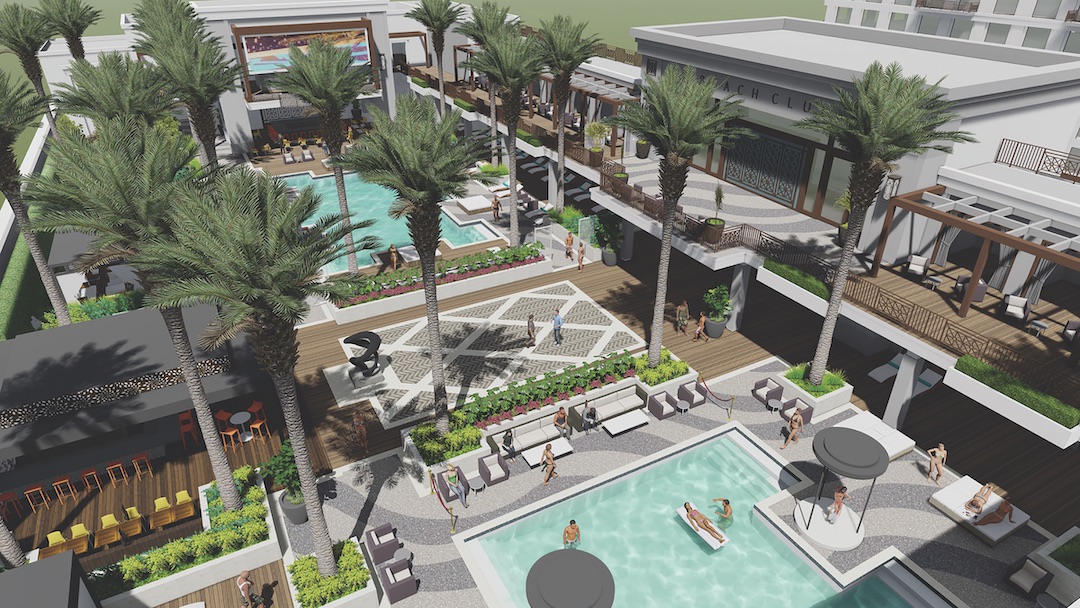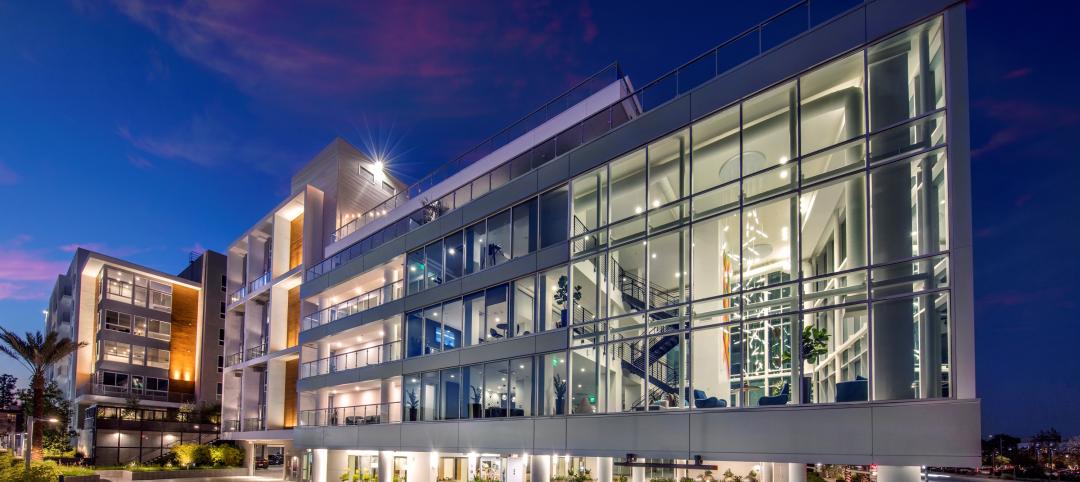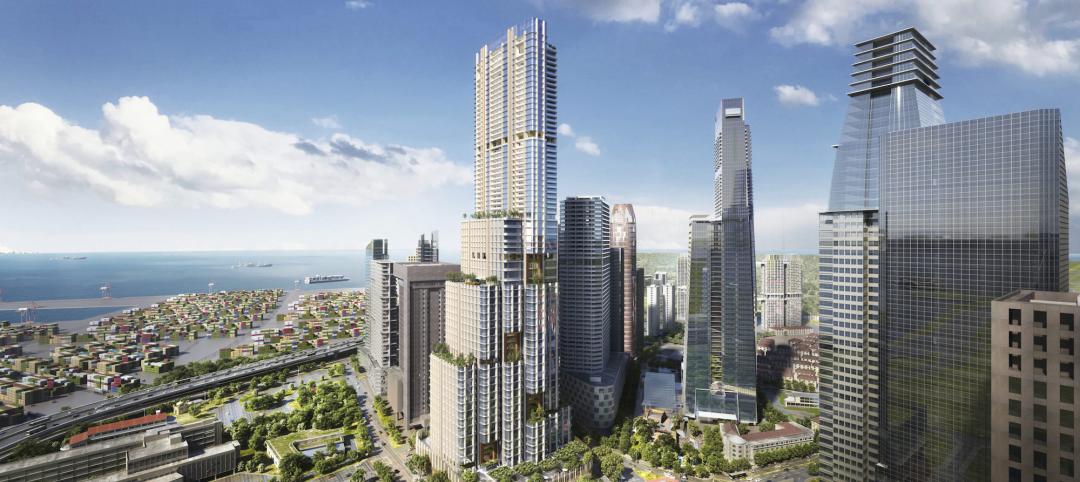During the early months of 2020, construction is scheduled to start in Irvine, Calif., on BANC, a 250-key luxury hotel with 16 condos and 150,000 sf of office space. Sitting atop that building’s parking garage will be a 40,000-sf roof deck with two swimming pools, a 6,500-sf nightclub, and $1.4 million in landscaping.
The landscaping will contribute to providing a level of intimacy for an amenity that accommodates 1,200 people. Another element meant to create “a kind of Las Vegas experience” will be 40 rentable cabanas, including six that fit up to 20 people each, says Rob Budetti, NCARB, CDP, LEED GA, Partner with AO Architects, this project’s designer.
BANC accentuates how roof deck entertainment spaces have become prevalent, even essential, in new construction and as additions to existing buildings. The amenity has become a prominent feature for office buildings, offering “an accessible, secure extension of the occupants’ workplace,” explains John Crump, Vice President and Workplace Studio Leader for SmithGroup’s Washington, D.C., office, whose recent projects include the District Center at 555 12th Street NW, with a 10,000-sf outdoor terrace.
When considering a roof entertainment space, project teams must address several factors: weight loads, moisture control and rainwater management, wind uplift, and occupant safety. The BANC project, for example, must account for the pools’ depth (3½ to 4 feet) and planters with six feet of planting depth, says Diego Alessi, ASLA, Principal and Director of AO Architects’ landscape studio.
There are four types of loads—snow, rain, live, and dead—that any roof deck design manages, says Blair Hildahl, PE, LEED AP, CMO and Founding Partner with Base4, an AE firm based in LaCrosse, Wis. He adds that if shear walls don’t extend above the roof level, the rooftop structure must be able to withstand lateral loads from seismic and wind activity.
“Planning for a roof deck needs to happen at the concept stage,” says Hildahl. “The challenge is to make egress, accessibility, insulation requirements, and waterproofing/drainage work together efficiently.”
That gets complicated when the amenity is being dropped onto an older building whose original structural design only figured on snow and dead loads on the roof.
Chicago-based architecture and construction firm Epstein designed the conversion of the Conrad Chicago from an office building to a hotel. The owner, Lawrence Geller, insisted on adding a dynamic roof, so Epstein had to make sure the building’s columns could handle the extra load. The columns were reinforced with a carbon-fiber spray, and beams were installed under the roof slab, says David Scott, AIA, Epstein’s Director of Hospitality.
Roof deck amenities are typically built in layers, and the lower layers “are probably not going to be touched again for a very long time,” says Craig Hargrove, AIA, LEED AP, CDT, RRC, Senior Vice President and Director of Architecture with Hoffmann Architects. “So how those layers get built is important because they can be fabulously expensive.”
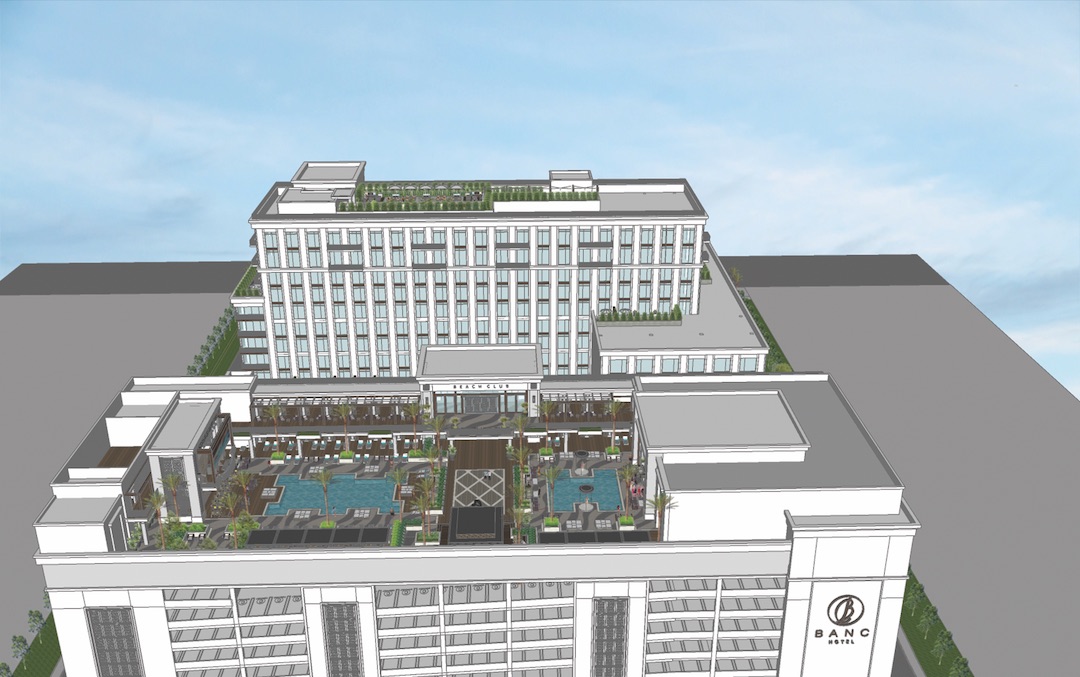
Hargrove notes that a deck must deal with the pitch that funnels rainwater from the roof to drains. But a ½-inch incline in the walking surface “can be noticeable and disturbing psychologically” to people standing on it.
Water can be moved to drains at two levels: at the structural deck where the waterproofing membrane is often installed, and above the deck at the walking surface. If these two surfaces drain independently, each can have two different pitches, allowing the walking surface to have a slope that is more conducive to the use of the space. In other cases, such as with loose laid pavers on a pedestal system over the structural deck, the walking surface can be level with no pitch, because water that might collect at the walking surface will drain to the structural deck between the pavers. The pitch of the roof then moves the water by gravity to the drains.
Another approach—and one that is typically less expensive—is to stack high-density plastic adjustable shims, known as screw jacks, under the corners of the deck to level the panels.
In any reconstruction that involves a roof deck, “it’s important to consider insulation placement,” advises Carl Baldassarra, Principal and Unit Manager with Wiss, Janney, Elstner Associates (WJE). Improper installation below the roof deck can lead to problems such as increased freeze-thaw damage, efflorescence, and condensation.
To control moisture, WJE uses a separate waterproofing membrane, such as hot applied rubberized asphalt, which functions as an air barrier and vapor retarder on the surface of the deck, say WJE Principals Norbert Krogstad and Rich Koziol. (The choice of insulation, says Koziol, is currently confined to extruded polystyrene board because of its water-resistant properties.)
Hargrove of Hoffmann Architects notes that the trick is to keep the roof’s membrane as far away from the asset as possible to protect the membrane, which is a key component in moisture control. Penetration points therefore should be flashed and detailed carefully.
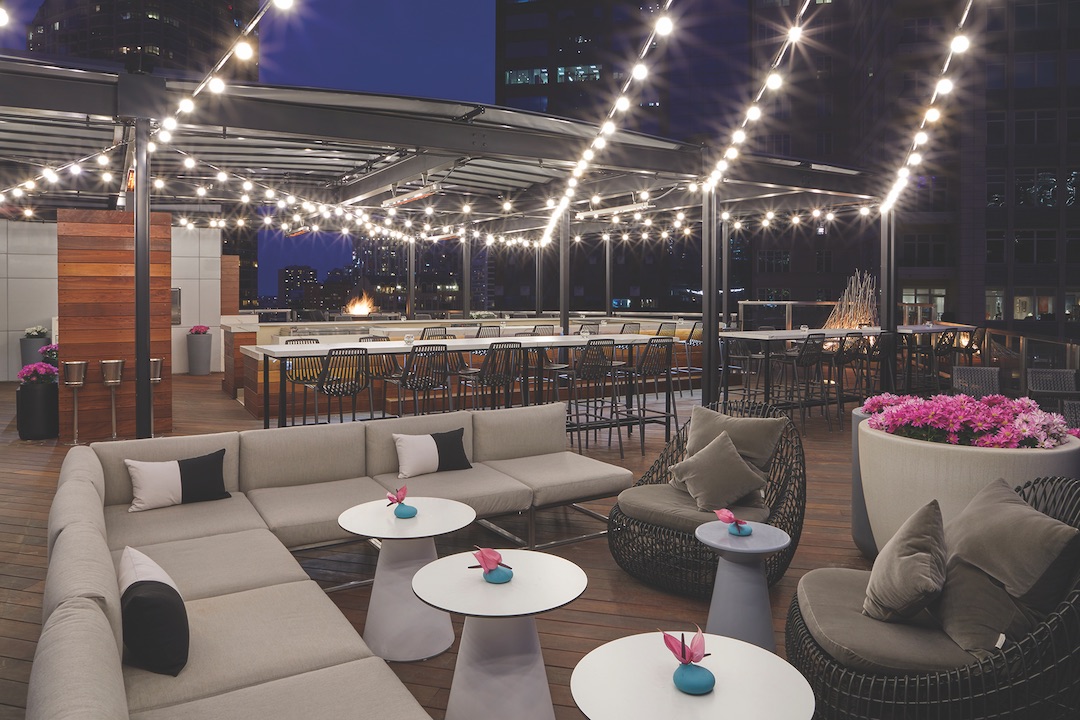 The roof deck amenity atop the Conrad by Hilton hotel in Chicago—an adaptive reuse of an office building—required that the building’s structural columns be reinforced to hold the extra weight. Roof deck amenities must also handle wind lift when installing flooring and furniture. Photo: Neal Burger/courtesy Epstein.
The roof deck amenity atop the Conrad by Hilton hotel in Chicago—an adaptive reuse of an office building—required that the building’s structural columns be reinforced to hold the extra weight. Roof deck amenities must also handle wind lift when installing flooring and furniture. Photo: Neal Burger/courtesy Epstein.
Getting the entertainment space to intersect seamlessly with the roof’s rainwater drainage system is a design imperative. But, Scott cautions, “People don’t want to see what you’re doing to remove water.”
To manage rainwater, BANC’s roof deck amenity will be built on paving materials atop a pedestal-like system that, at different areas, will be between six and 18 inches above the roof. Irrigation and drainage will go through the underdeck space. Planters will have their own drainage system that’s filtered through a biofiltration swale (a requirement in California).
Wind can play havoc on outdoor entertainment spaces. WJE’s Krogstad says that, depending on the space and the height of the building, it might be necessary to anchor the deck or terrace finishes to the structure below. Hargrove points out that manufacturers offer paver-locking systems, in wood or precast concrete, so that the roof itself acts as a large unit of ballast.
See Also: Passive House picks up steam
Base4’s Hildahl notes that the deck height can affect the elevator landing heights. “And if there’s a kitchen or any covered spaces, they need to be raised, too; otherwise you may need a ramp for such spaces.”
The number of exit doors, stairs, sprinklers, standpipes, and elevators that a roof deck entertainment space must have is spelled out in codes that, for an existing building, sometimes lead to reconstruction. “It’s sort of the reverse from the way most buildings are designed” because people are moving back and forth from the top of the building, says Epstein’s Scott. For the Conrad Chicago project, the Building Team had to deconstruct a section of the building to make way for a second stairwell.
In the interest of occupant safety, rooftop spaces used by the public need to be reviewed for guardrail height, says WJE’s Baldassarra. Roof decks on tall buildings might also limit the use of combustible materials such as wood decking.
Related Stories
Multifamily Housing | Feb 16, 2023
Coastal Construction Group establishes an attainable multifamily housing division
Coastal Construction Group, one of the largest privately held construction companies in the Southeast, has announced a new division within their multifamily sector that will focus on the need for attainable housing in South Florida.
Affordable Housing | Feb 15, 2023
2023 affordable housing roundup: 20+ multifamily projects
In our latest call for entries, Building Design+Construction collected over 20 multifamily projects with a focus on affordable housing. Here is a comprehensive list of all projects in alphabetical order.
Multifamily Housing | Feb 11, 2023
8 Gold and Platinum multifamily projects from the NAHB's BALA Awards
This year's top BALA multifamily winners showcase leading design trends, judged by eight industry professionals from across the country.
Multifamily Housing | Feb 10, 2023
Dallas to get a 19-story, 351-unit residential high-rise
In Dallas, work has begun on a new multifamily high-rise called The Oliver. The 19-story, 351-unit apartment building will be located within The Central, a 27-acre mixed-use development near the Knox/Henderson neighborhood north of downtown Dallas.
Mixed-Use | Dec 7, 2022
Bjarke Ingels’ first design project in South America is poised to open next year in Ecuador
In 2013, Quito, Ecuador’s capital, opened its new airport, which had been relocated from the metro’s center to an agricultural site 12 miles northeast of the city. Since then, Quito’s skyline has been reshaped by new, vertical structures that include the 24-story mixed-use EPIQ Residences, designed in the shape of a quarter circle by Bjarke Ingels Group (BIG).
High-rise Construction | Dec 7, 2022
SOM reveals its design for Singapore’s tallest skyscraper
Skidmore, Owings & Merrill (SOM) has revealed its design for 8 Shenton Way—a mixed-use tower that will stand 63 stories and 305 meters (1,000 feet) high, becoming Singapore’s tallest skyscraper. The design team also plans to make the building one of Asia’s most sustainable skyscrapers. The tower incorporates post-pandemic design features.
Office Buildings | Dec 6, 2022
‘Chicago’s healthiest office tower’ achieves LEED Gold, WELL Platinum, and WiredScore Platinum
Goettsch Partners (GP) recently completed 320 South Canal, billed as “Chicago’s healthiest office tower,” according to the architecture firm. Located across the street from Chicago Union Station and close to major expressways, the 51-story tower totals 1,740,000 sf. It includes a conference center, fitness center, restaurant, to-go market, branch bank, and a cocktail lounge in an adjacent structure, as well as parking for 324 cars/electric vehicles and 114 bicycles.
Mixed-Use | Dec 6, 2022
Houston developer plans to convert Kevin Roche-designed ConocoPhillips HQ to mixed-use destination
Houston-based Midway, a real estate investment, development, and management firm, plans to redevelop the former ConocoPhillips corporate headquarters site into a mixed-use destination called Watermark District at Woodcreek.
Data Centers | Nov 28, 2022
Data centers are a hot market—don't waste the heat!
SmithGroup's Brian Rener shares a few ways to integrate data centers in mixed-use sites, utilizing waste heat to optimize the energy demands of the buildings.
Mixed-Use | Oct 20, 2022
ROI on resilient multifamily construction can be as high as 72%
A new study that measured the economic value of using FORTIFIED Multifamily, a voluntary beyond-code construction and re-roofing method developed by the Insurance Institute for Business & Home Safety (IBHS), found the return can be as high as 72%.


